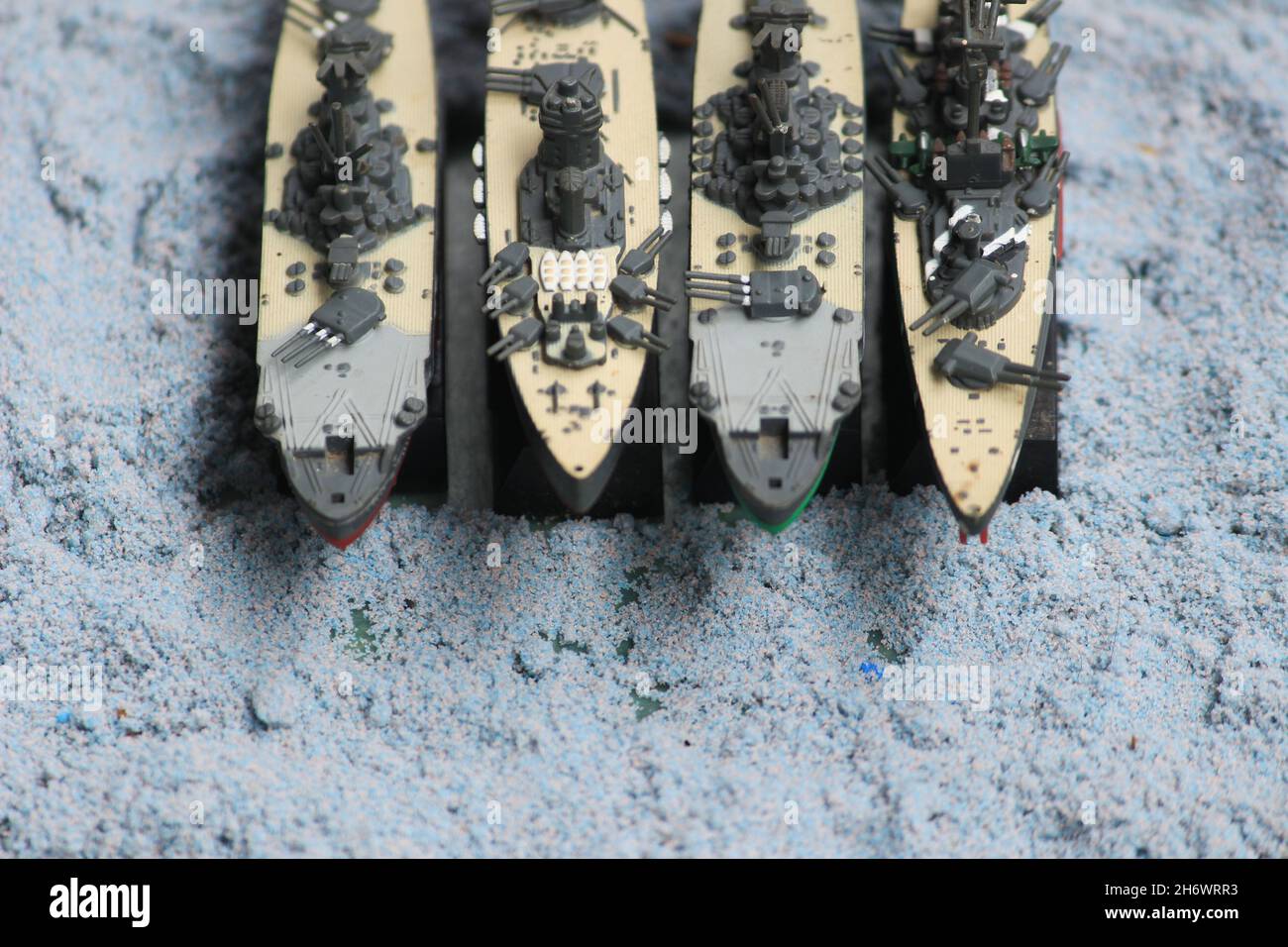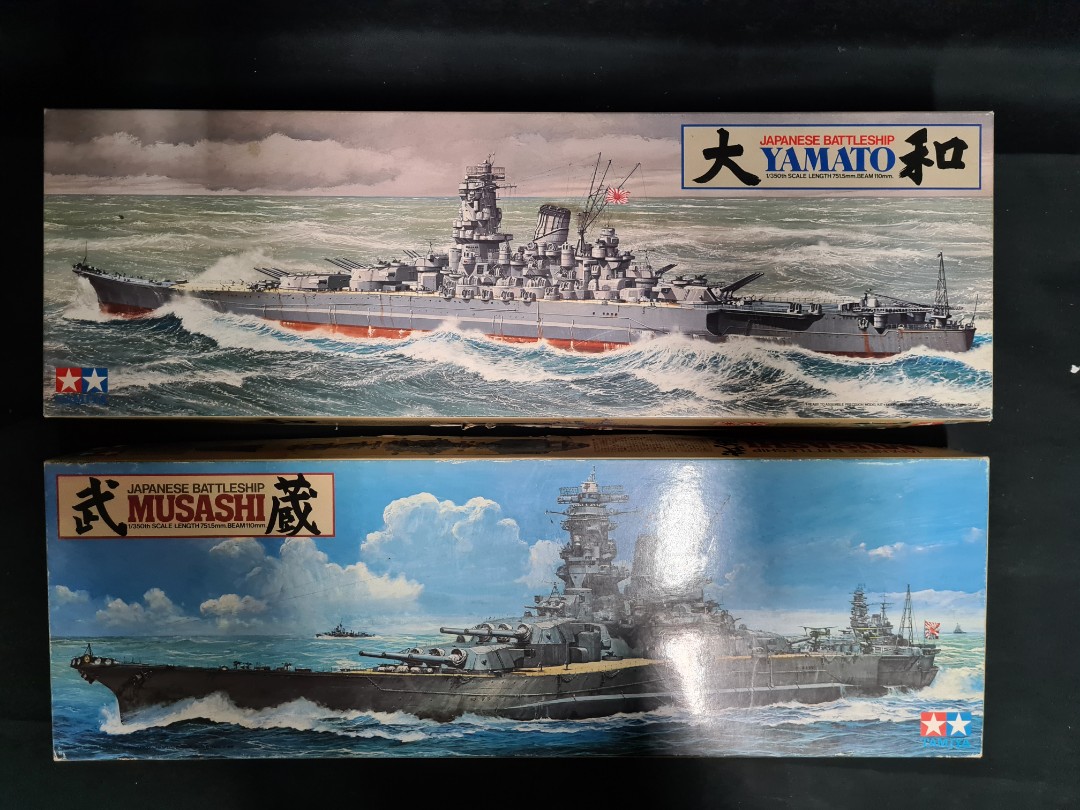Musashi Vs Yamato - The Yamato-class battleships (大和型戦艦 , Yamato-gata skan ) are two battleships of the Imperial Japanese Navy (IJN), Yamato and Musashi, which were laid down before World War II and completed as which is planned. The third hull laid down in 1940 was converted into an aircraft carrier, Shinano, during construction.
Displacing nearly 72,000 long tons (73,000 t) at full load, the completed battleships were the heaviest ever built. The class carried the largest naval armament ever mounted on a battleship, nine 460 mm (18.1 in) naval guns, each capable of firing 1,460 kg (3,220 lb) of ammunition. over 42 km (26 mi).
Musashi Vs Yamato
Due to threats from American submarines and aircraft carriers, Yamato and Musashi spent most of their careers at the naval bases at Brunei, Truk and Kure - placing the several times in response to American attacks on Japanese bases.
Fujimi Next Musashi Vs Pit Road Yamato 1/700. Which One Is Best?
All three ships were sunk by the US Navy; Musashi while participating in the Battle of Leyte Gulf in October 1944, Shinano while en route from Yokosuka to Kure for resupply in November 1944, and Yamato while en route from Japan to Okinawa as part of Operation T-Go in April 1945.
The design of the Yamato class battleships was shaped by the expansionist movements of the Japanese government, Japan's industrial power, and the need for a powerful navy to intimidate enemies.
The most important, finally, is in the form of the Kantai Kes ("Decisive Battle Doctrine"), a naval strategy adopted by the Imperial Japanese Navy before World War II in which the Japanese Navy would win in war by fighting and winning alone. maritime decision making.
After the First World War, the building projects that started during the conflict continued and expanded. The high costs associated with these projects forced their government leaders to initiate a conference. On July 8, 1921, United States Secretary of State Charles Evans Hughes invited representatives from the other major naval powers—France, Italy, Japan, and the United Kingdom—to come to Washington. discuss a naval battle race. Another naval conference in Washington resulted in the Washington Naval Treaty. Among many other things, it limited all future battleships to a displacement of 35,000 long tons (35,562 t; 39,200 short tons) and a gun caliber of 16 inches ( 406 mm). It is also agreed that the five countries will not build new capital ships for ten years and will not replace the ships that survived the agreement until the end of twenty years.
Premium Ship Review: Musashi
This move forced the expansion of the Japanese empire to include much of the Pacific Ocean and Southeast Asia. To maintain such an empire—which stretches 3,000 miles (4,800 km) from China to Midway Island—requires a large fleet to permanently control the land.
Although all Japanese warships built prior to the Yamato class were decommissioned before 1921—because the Washington Treaty was no longer abrogated—they were rebuilt or rebuilt. Second, in the 1930s.
This innovation, among other things, was more speed and firepower, which the Japanese wanted to use to conquer and develop their desired empire.

When Japan withdrew from the League of Nations in 1934 due to the Muqd Incident, it renounced all treaty obligations.
Wwii's Largest Battleship Revealed After 70 Years Underwater
Japan's desire to acquire industrial colonies in the Pacific and Southeast Asia led to conflict with the United States.
Therefore, America became Japan's first enemy. The US has a greater industrial influence than Japan, with 32.2% of global industrial production compared to Japan's 3.5%.
In addition, several prominent members of the United States Congress vowed to "outnumber Japan three to one in the ocean race."
Japanese shipbuilders developed designs for new warships that were more efficient than their counterparts in the United States Navy.
File:musashi Battleship In 1942.jpg
Each of these warships can accommodate multiple Emmi capital ships at once, eliminating the need to outsource industrial operations such as the US in building warships. .
The first studies for a new class of warships were started after Japan's withdrawal from the League of Nations and the termination of the Washington and London Naval Agreements; from 1934 to 1936, 24 original designs were produced. These early designs differed in armor, propulsion, endurance and weapons. Large differences vary between 460 mm (18.1 in) and 406 mm (16 in) guns, while secondary armament has varying numbers of 155 mm (6.1 in), 127 mm (5 in) and with 25 mm (1 in) guns. . Powering most designs is a diesel-turbine hybrid, although some rely solely on diesel and others are designed for turbines only. The maximum range of the various designs is between 6,000 nautical miles (11,000 km; 6,900 mi) in the A-140-J design.
, with a speed of 18 knots (33 km/h; 21 mph). The armor varied between providing protection from the fire of the 406 mm guns to armor protection from the 460 mm guns.
. Due to their wide range (4,900 nmi (9,100 km; 5,600 mi) by 7,200 nmi (13,300 km; 8,300 mi) at 16 knots (30 km/h; 18 mph), they were used to establish a first study. , completed on 20 July 1936. Changes to that plan resulted in the final plan of March 1937,
Yamato Class Post Ww2 Refit By Tzoli On Deviantart
A range of 7,200 nmi was finally decided upon, and diesel-turbine wheel propulsion was abandoned for turbines. Diesel engines were removed from the design due to problems with the engines on the Taigei submarine.
Their giants, like those to be installed in new warships, require "great repair and maintenance".
In addition, if the gins are tired of falling, the 200 mm (7.9 in) castle is protected in the intended diesel engine rooms and related engine areas when trying to open and close it. they.
The final design called for a standard displacement of 64,000 long tons (65,000 t) and a full cargo displacement of 69,988 long tons (71,111 t).
Victory At Sea
Making the ships of the class the largest warships ever built and the largest warships ever built. The design called for a large armament of nine 460 mm naval guns mounted in three high guns – each heavier than a 1930s destroyer.
Although five Yamato-class ships were planned in 1937, only three were completed - two battleships and one converted aircraft carrier. The three ships were built in complete secrecy, in order to prevent American intelligence officials from knowing their existence and details;
In fact, the US Navy recognized Yamato and Musashi by name in late 1942. At first, they were far from certain about the class; Although their length was correct, the class was provided with a beam of 110 ft (34 m) – actually, about 127 ft (39 m) and a displacement of 40,000–57,000 tons (actually, 69,000 tons) . Also, the Yamato-class' main armament of nine 16 in (410 mm) guns was not delivered until July 1945, four months after Yamato's sinking.

Jane's Fighting Ships and the Western media have also misrepresented the details of the ship. In September 1944, Jane's battleships estimated the displacement of Yamato and Musashi to be 45,000 tons.
H 044 3: Death Of Battleship Yamato
Similarly, the New York Times and the Associated Press reported that the two ships moved 45,000 tons at a speed of 30 knots.
And after the sinking of Yamato in April 1945, the Times of London continued to report 45,000 tons as the ship's displacement.
However, the ships' existence—and their alleged violation of maritime treaties—prompted American naval engineers to design the 60,500-ton battleships Montana- class, although they were not designed against the Yamato-class.
Yamato was commissioned in March 1937, laid down on 4 November 1937, launched on 8 August 1940 and commissioned on 16 December 1941.
Fujimi Fune Next 014 Ijn Battleship Yamato 1941 Completion 1/700 Scale
She trained until 27 May 1942, when Admiral Isoroku Yamamoto deemed the ship "navigable".
Attached to the 1st Fighter Division, Yamato served as the flagship of the Japanese Combined Fleet at the Battle of Midway in June 1942, but did not engage enemy forces in the battle.
The next two years were equally divided between the Truk and Kure naval bases, with her sister ship Musashi replacing Yamato as the flagship of the Combined Fleet.

During this period, Yamato, as part of the 1st Battle Division, deployed several times against American attacks on the Japanese island bases. On 25 December 1943, she received heavy damage from a torpedo by USS Skate and was forced to return to Kure for repairs and improvements to the hull.
Whats The Difference?? Yamato Class
In 1944—after upgrading the main aircraft and improving the secondary batteries—Yamato participated in the Second Fleet in the Battle of the Philippine Sea, serving as the flagship of the Japanese shipping sector.
In October 1944, as part of Vice Admiral Takeo Kurita's Cter Force for the Battle of Leyte Gulf, he used his warships against enemy ships only temporarily, assisting targeting the US escort carrier Gambier Bay and the destroyer Johnston before being hit by a torpedo from Hermann, which destroyed her.
Yamato has increased in carnage
Yamato musashi, tirpitz vs yamato, yamato vs iowa, musashi and yamato, arcadia vs yamato, miyamoto musashi vs sasaki kojiro, yamato vs bismarck, uss missouri vs yamato, hms hood vs yamato, yamato battleship vs bismarck, uss iowa vs yamato, musashi vs kojiro

0 Comments